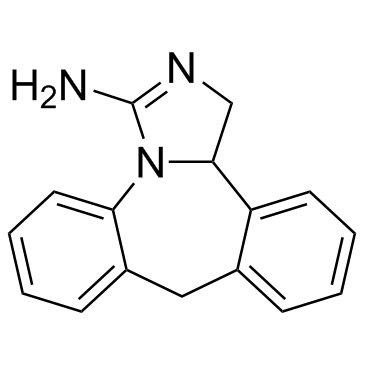Epinastine (WAL801) |
| Katalog-Nr.GC31708 |
Epinastine (WAL801) (WAL801) ist ein Antihistaminikum und Mastzellstabilisator.
Products are for research use only. Not for human use. We do not sell to patients.

Cas No.: 80012-43-7
Sample solution is provided at 25 µL, 10mM.
Epinastine(WAL801) is an antihistamine and mast cell stabilizer that is used in eye drops to treat allergic conjunctivitis.Target: Histamine ReceptorEpinastine shows a high affinity to H1-receptors in receptor binding studies in the guinea pig ileum. Epinastine inhibits histamine-induced reactions in the skin or the lung of rats, dogs and guinea pigs [1]. Epinastine is able to displace specific [3H]NC-5Z binding at low concentrations in the locust nervous tissue. Epinastine binds to the honey bees neuronal octopamine receptor with Ki of 1.1 nM. Epinastine antagonises octopamine-induced cAMP formation in the insect brain [2]. Epinastine causes an inhibition of histamine release from rat peritoneal mast cells induced by both antigen-antibody reaction and compound 48/80. Epinastine is similarly effective in inhibiting compound 48/80-induced histamine release not only from isolated rat peritoneal mast cells but also from rat mesenterial pieces. Epinastine is effective in inhibiting not only Ca2+ uptake into lung mast cells in actively sensitized guinea pigs but also Ca2+ release from the intracellular Ca store of rat peritoneal mast cells exposed to both compound 48/80 and substance P [3]. Epinastine shows a dose- and time-dependent suppressive effect on IL-8, one of the chemokines for eosinophils, released from eosinophils isolated from atopic diseases [4].
[1]. Fugner, A., et al., In vitro and in vivo studies of the non-sedating antihistamine epinastine. Arzneimittelforschung, 1988. 38(10): p. 1446-53. [2]. Roeder, T., J. Degen, and M. Gewecke, Epinastine, a highly specific antagonist of insect neuronal octopamine receptors. Eur J Pharmacol, 1998. 349(2-3): p. 171-7. [3]. Kamei, C., et al., Antiallergic effect of epinastine (WAL 801 CL) on immediate hypersensitivity reactions: (I). Elucidation of the mechanism for histamine release inhibition. Immunopharmacol Immunotoxicol, 1992. 14(1-2): p. 191-205. [4]. Kohyama, T., et al., A novel antiallergic drug epinastine inhibits IL-8 release from human eosinophils. Biochem Biophys Res Commun, 1997. 230(1): p. 125-8.
Average Rating: 5 (Based on Reviews and 4 reference(s) in Google Scholar.)
GLPBIO products are for RESEARCH USE ONLY. Please make sure your review or question is research based.
Required fields are marked with *




















